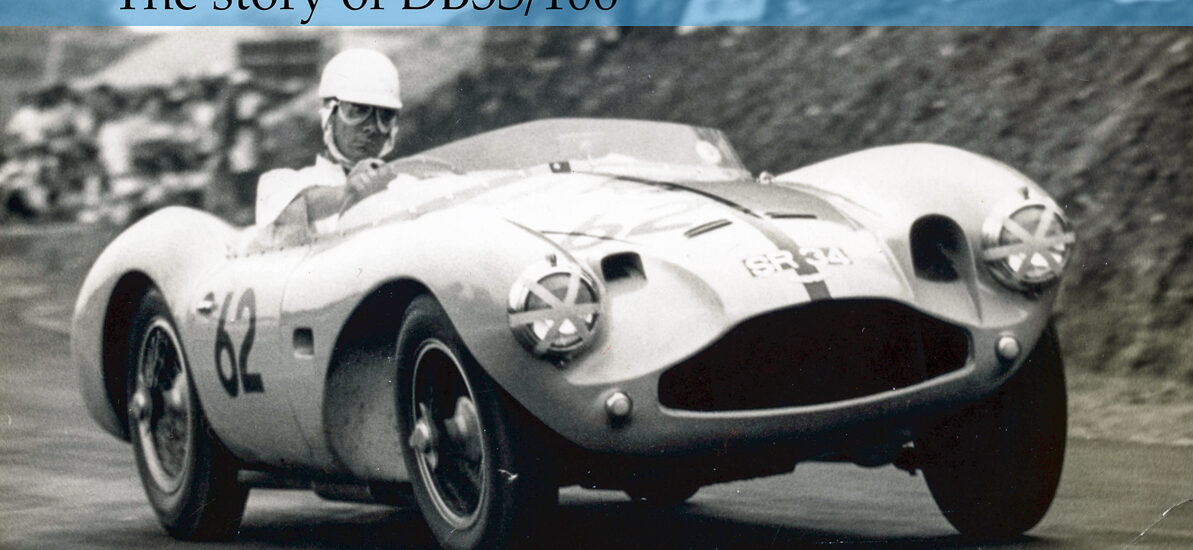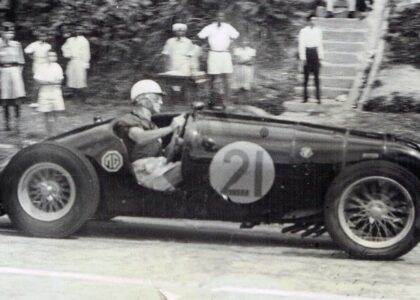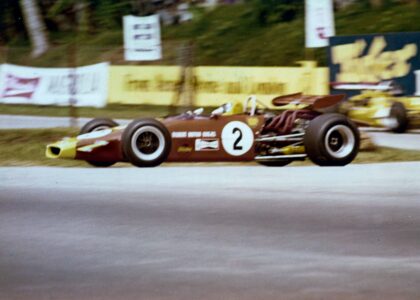A Short History of the Asian history of Aston Martin DB3S/106
By Eli Solomon
Updated with additional images in June 2022.
Updated with film footage and additional images in April 2022.
“After we had won the world championship with the sports cars in 1959 we stopped sports car racing entirely to put all the effort into the F1 cars but it was just too late by then. Jack Brabham had won the 1959 world championship in a Cooper and suddenly front-engined cars were out of date.” – Aston Martin’s John Wyer in his autobiography, The Certain Sound1.
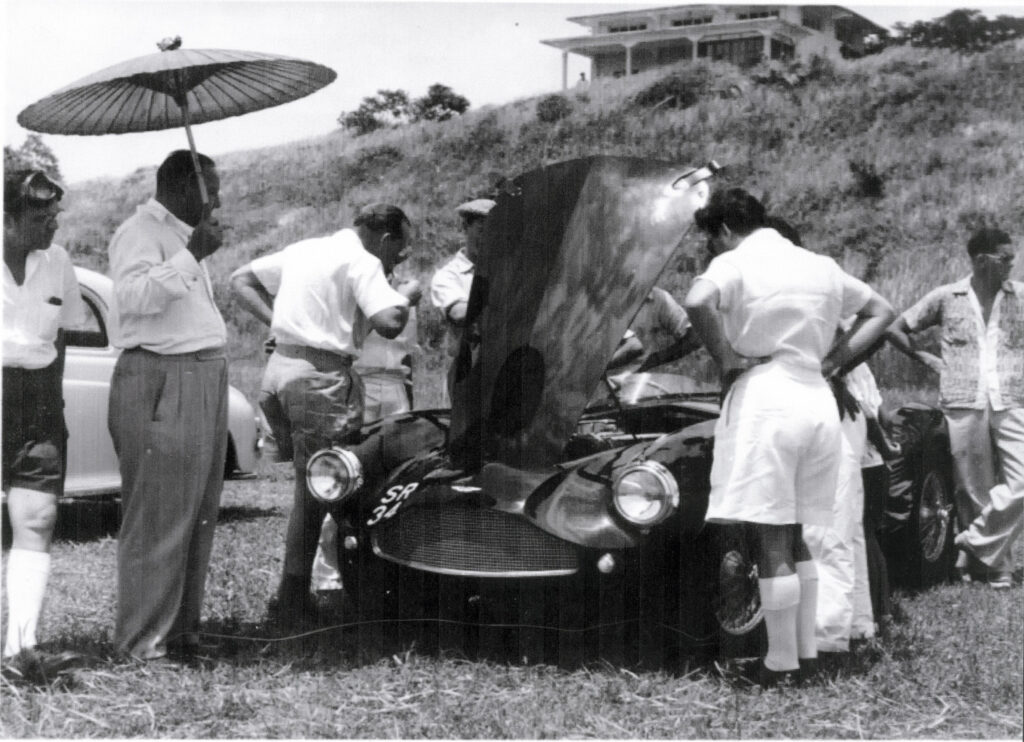
Chan Lye Choon’s Aston Martin DB3S-106 when it first arrived in Singapore in 1955. The dark blue car had yet to undergo refinements to airflow following its unsuccessful attempt at the 1955 Macau Grand Prix.
Out in the colonies, one Aston Martin sports car continued to make headlines…right up to 1964!
The history of this car goes back several years, to November 1952, in fact, on board P&O’s ocean liner SS Chusan2 on one of its voyages from Great Britain to Yokohama, via Singapore. On board was a young Richard M. ‘Dickie’ Arblaster on his maiden voyage to Singapore to work for then Austin importers Borneo Motors. He was informed that a certain “Elsie” Chan was returning home as well, which piqued the interest of the Englishman. Turned out that “Elsie” was a 34-year-old gentleman, L.C. Chan. 34-year-old Chan Lye Choon4 and a respected member of the Straits-Chinese community in Singapore. Chan Swee Hong passed away on 13th September 1949 at his home at Lorong N Telok Kurau Road. With the patriarch’s passing the business devolved upon his four sons, Lye Soon, Lye Huat, Lye Choon and Lye Koon. Sunny Joseph Chan Lye Huat [b. d. 6 July 1992] and Lye Choon would soon emerge as Singapore’s top race drivers of the early to mid 1950s, a subject that is covered extensively by the Chan family.[/efn_note] was returning home from a business trip during the summer of 1952. This morsel of information precisely dates Chan’s visit to Slough6 market; the other was to purchase a pair of Formula 3 Cooper JAPs from the Cooper Works at Hollyfield Road in Surbiton.
TOP END
There weren’t many car marques Chan could avail himself of that did not already have a presence in Asia. The war had ravaged Europe, and in 1952, there were barely any supercar manufacturers in the United Kingdom. Bentley was an old boys’ brand and Rolls-Royce cars could hardly be called sporting. Alvis and Allard were too exclusive and already under George Lee Motors and ACs were an unknown quantity. Renault, Singer, Jaguar and Mercedes-Benz were handled by Cycle & Carriage Co. and MGs came under Wearnes’ Malayan Motors. The David Brown name however, would have been known to the agricultural community in Asia, better known as gearbox manufacturers. Brown’s acquisition of the Aston Martin brand in 1947 and subsequent successes with the DB2 sports car must have caught Chan’s attention. By early 1953, Eastern Auto was advertising the Aston Martin DB2-4 in the local papers. There were at least a couple of early 1950s DB2s in the region already. This wasn’t a mainstream acquisition by any means at the time, the Citroën marque was a relatively good selling car in the Far East. But it, and the addition of Cooper racing cars, added some glamour to the name of the company, and gave the two brothers an opportunity to have some fun showing off their cars at the sprints and hill climbs throughout Malaya.
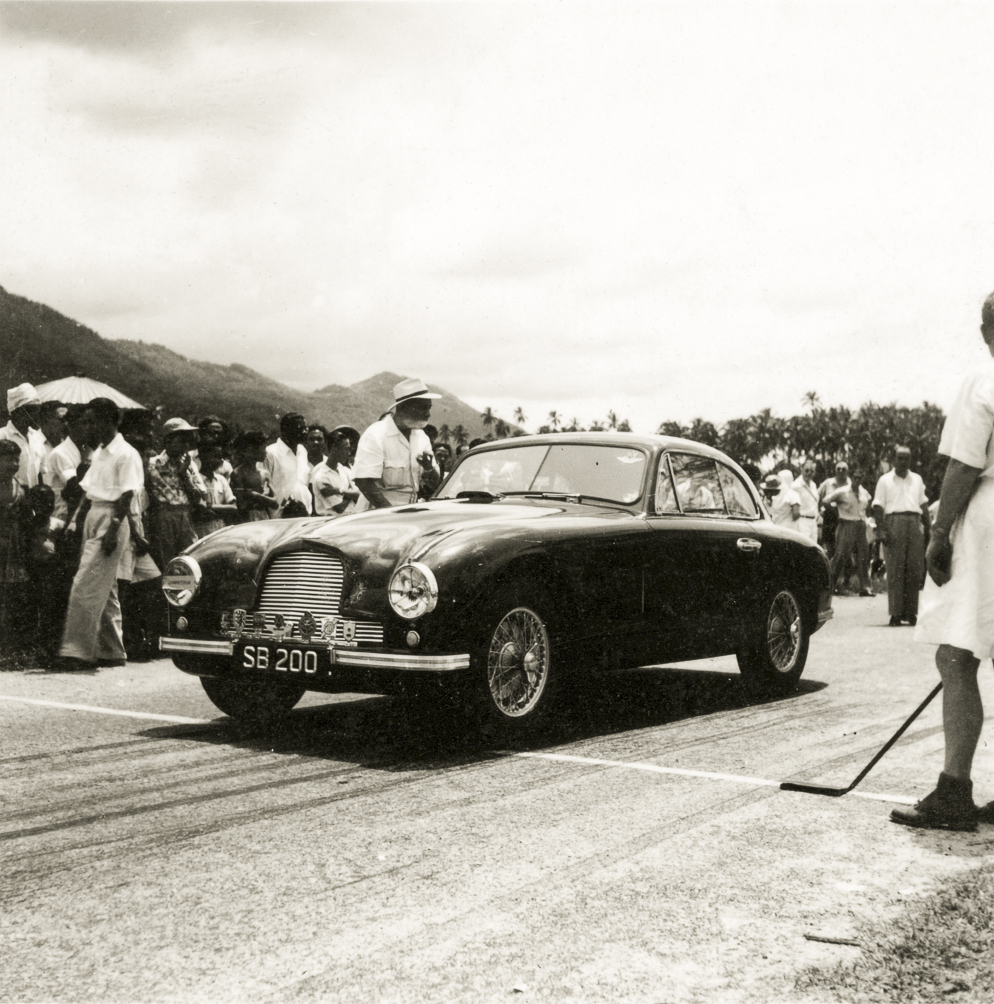
One of the earliest post-war Aston Martins to be sent to Malaya was this DB2-4, seen at the Sungei Nibong Sprint in Penang, May 1953.
Fast forward to February 1955 when an impressive-looking dark blue sports car turned up at the Eastern Auto showroom at 77-79 Orchard Road. The company’s top seller then was still the Slough-built Citroëns, of which the 2-litre front-wheel drive DS19 was the latest hit. The striking latest arrival however caught the attention of the growing community of motoring enthusiasts with equally growing disposal incomes. One of just 20 customer cars built, Aston Martin DB3S/106 was perhaps one of the most attractive automobiles to arrive on local shores, and easily the most expensive. Built in 1954, it was priced at an astonishing equivalent of SGD25,000, the cost of a small house in Singapore. Compared to a new Jaguar XK120 Roadster at SGD10,800 from neighbouring distributor Cycle & Carriage Ltd.7 , the Aston Martin, when it arrived in early 1955, was in the supercar league and was the top of the range for Eastern Auto’s products, which apart from Citroën, included DKW and Lancia cars, and Francis Barnett and Vincent motorcycles. The DB3S wasn’t for sale!
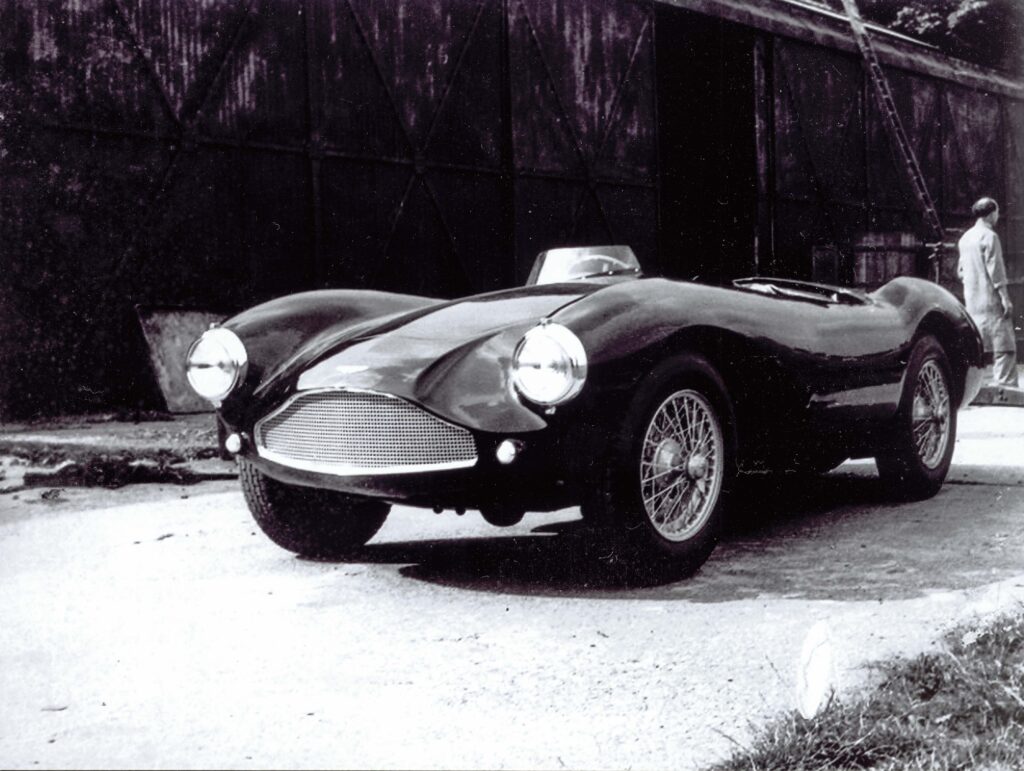
DB3S/106 was built as a customer car.
FACTORY REFRESH
The DB3S’ arrival coincided with a major resurgence of the sport in Asia. The Portuguese enclave of Macau was motor racing’s mecca of the Far East after the Johore Grand Prix race was cancelled after 1953. It was, therefore, no surprise that some of the keener Singapore racers looked forward to Macau in November 1955.
There were four Chan brothers, but only two, Lye Choon and Lye Huat, who was a year older, were enthusiastic about motor sport and had the skill to go racing. The brothers shipped two Aston Martins to Macau – the dark blue DB3S8 for Lye Choon and a DB2/4 Coupe9 or Lye Huat, the cars leaving for Hong Kong on 22 October 1955. The dark-coloured DB3S, running #9, started on the third row of the grid, in seventh place, but blew a head gasket (due to a burst oil pipe) during the race. Lye Huat, with the #10 DB2/4, started at the back of the grid and gallantly finished in fourth place, two laps behind the winning Austin Healey 100.
The DB3S was swiftly returned to the Aston Martin factory at Feltham for upgrades to engine and bodywork, ostensibly to aid in cooling. Its owner then headed to Britain in early February 195610 to spend a month in the United Kingdom where he visited various car factories. Included in his trip was a visit to the Aintree International motor meeting on 21 April 1956 where he watched Stirling Moss win the Aintree 200 Formula 1 race in a Maserati. Chan then met 53-year-old Steve Lancefield11, the expert tuner of Manx Norton “double-knocker” engines, where he received some useful tips for his Cooper that was to carry a Norton motor for the sub-750cc racing class at Malayan club meetings.
When the DB3S returned to Singapore, it looked stock standard, no works intakes on the front bodywork, no visible cooling ducts but the car was now cream in colour and made it Gap Hill Climb debut on 14 October 1956. There are no records to show if the engine was upgraded in any way although it probably was with work on the cylinder head and cooling but whatever the case, maintenance was entrusted to Eastern Auto’s chief mechanic Chan Siew Kwan. While Chan’s DB3S was initially a customer car, its factory repairs following the 1955 Macau Grand Prix would have been significant during the period when DB3S development was at its height under the technical directorship of the legendary John Wyer. Much had already been done to both engine and mechanicals of the DB3S race cars after Chief Engineer Professor “Robert” Eberan von Eberhorst had left the company, and one assumes that these improvements would have filtered down to Chan’s car while it was in rehabilitation in the UK. Whether the same DB3S returned is not known but as the car had never had a major prang, it stands to reason that whatever upgrades were done were to the very same car that Chan had originally acquired.
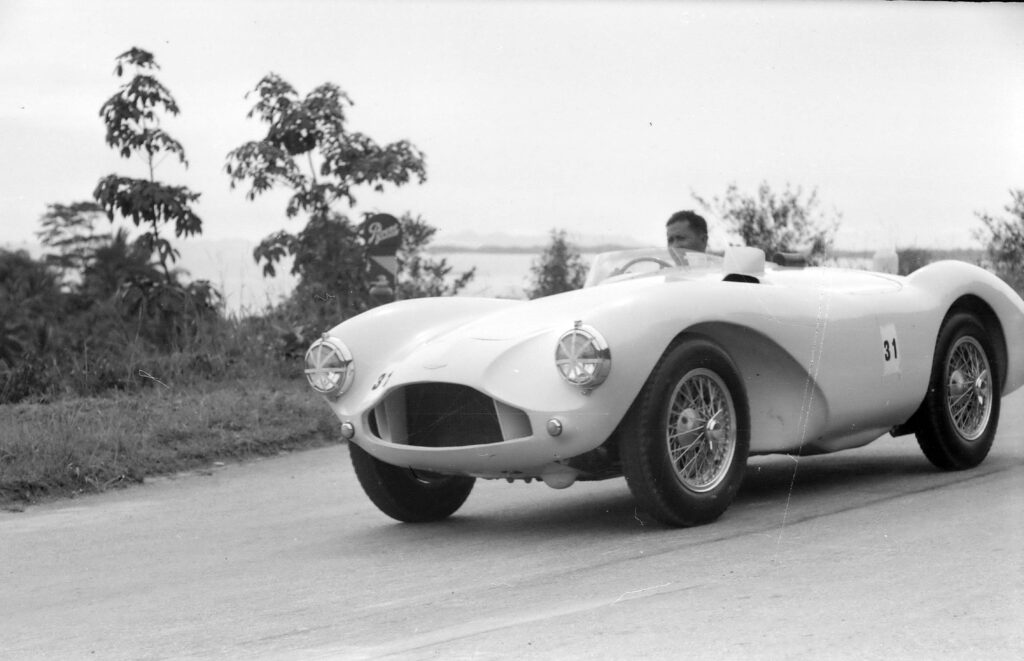
Newly painted and still without air flow refinements to the bonnet, the cream DB3S made its debut at the October 1956 Gap Hill Climb in Singapore. The photo shows its owner returning to the base of the Hill Climb on Pasir Panjang Road.
FIRST WINS
Chan skipped the 1956 Macau Grand Prix and the car made its sprint debut at the Lim Chu Kang Half-Mile Sprint on 24 March 1957, taking a class win in the process. It was still cream in colour.
At the Gap Hill Climb in May 1957, Chan was back in his stride with a now very aggressive-looking DB3S, with fresh air scoops on the bonnet, following the style of the works cars. May’s Gap Hill Climb was a teaser of what was to come the following month at the RAF base in Changi. The Singapore branch of the Forces Motor Club hosted the Changi Circuit Race12. It was here that Chan’s cream-coloured DB3S won its first big outing – the main race of the weekend. The Changi Circuit Race is documented in LANDING AT CHANGI in 1957.
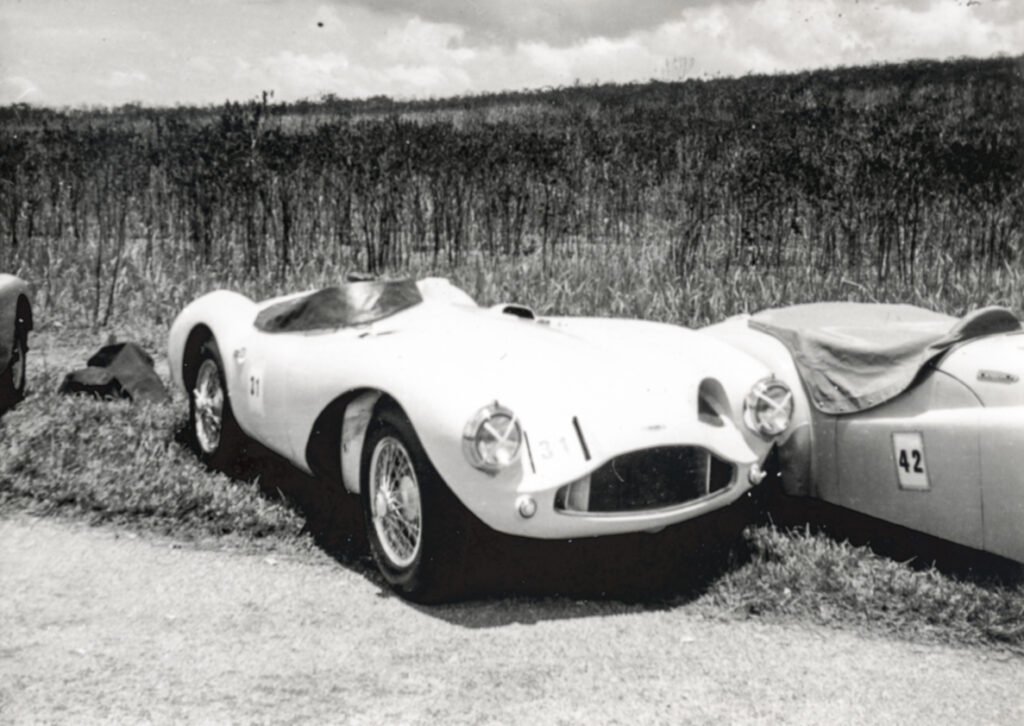
Chan Lye Choon’s white Aston Martin DB3S at the May 1957 Gap, following earlier factory modifications to aid cooling.
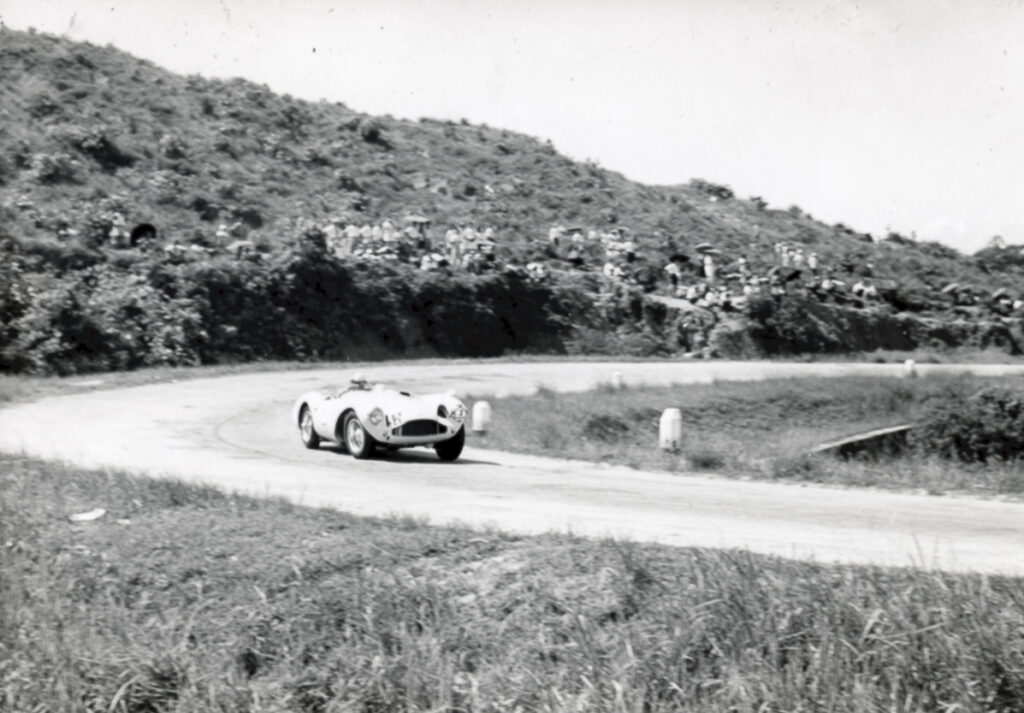
The Aston Martin DB3S won the Sports Cars Unlimited class with a 52.50 second run, significantly slower than FTD set by Lim Peng Han in the Lim Special.
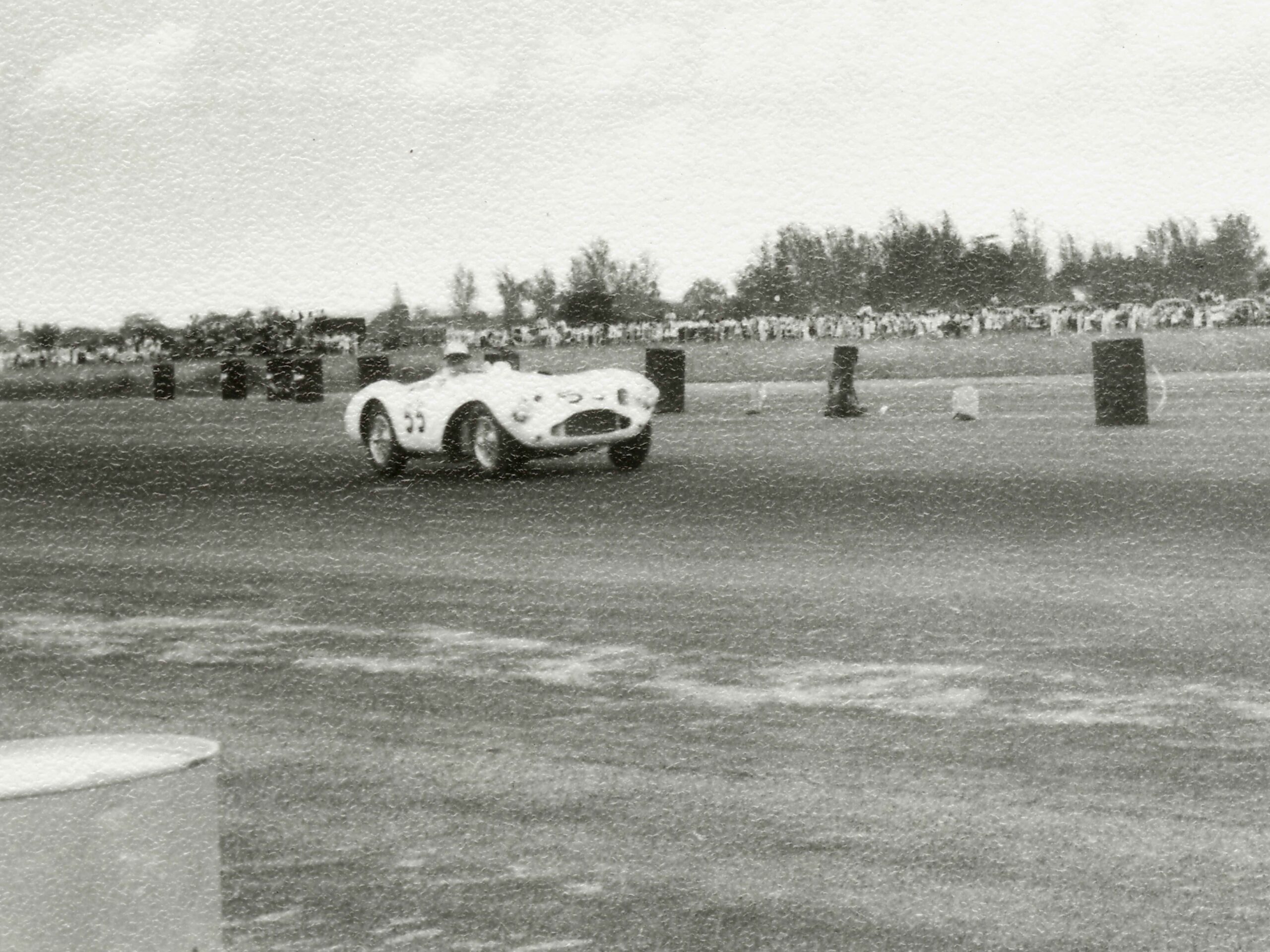
Now resplendent in a lighter shade of colour, the #55 DB3S won the 1957 Changi Circuit Race, the only occasion a circuit race was held at RAF Changi in Singapore. He led from start to finish against some very fast cars.
Would Chan enter the Macau Grand Prix that year to make amends for the failure in 1955 and for missing out on the 1956 Grand Prix? The Aston Martin would have to bide its time another year while Chan continued to race his Coopers and his newly-acquired twin cam MGA at the local club meetings throughout the year. By 1958, he was ready to return to Macau and the DB3S was put through its paces at the Lim Chu Kang Sprint, the Gap Hill Climb, and the treacherous Princess Elizabeth Estate Sprint. Prior to shipping the car to Hong Kong was the Dover Kilo held on Dover Road in Singapore on 21 September 1958. The car, looking very tidy and still sporting the air scoop on the bonnet, was now in a shade of British Racing Green, its third colour change.
SCORING BIG
There were at least six entries came from Singapore for the 1958 Macau Grand Prix. A few other Singapore residents were also entered in the support races. The suitably ‘tropicalised’ DB3S and tuned for the tough road course was accompanied by a gaggle of Singapore-registered race cars: a Jaguar XK Special13, the Warrior Bristol14, a supercharged Allard J2X15, a Mistral Special16, and a little Berkeley17. The Grand Prix had an entry list of 31 cars, though just 23 made it to the start line. It was a gruelling 60 lap race around the treacherous street circuit, fraught with telegraph poles and the potential for a dip in the South China Sea.
The Aston Martin took the fight to the Hong Kong racers with a tremendous victory that weekend, starting on the second row alongside Grant Wolfkill’s twin cam MGA but finishing a full lap ahead of its closest competitor, Ron Hardwick, in an AC Ace. Chan scored big time in Macau. He made triple history that day, for the first time, an Aston Martin, a Singapore driver, and a Chinese had won the Macau Grand Prix! The car also set Fastest Time of Day at 3m 31.5sec. Ordinarily, a race car dating from 1954 with an alarming tendency to lift at speed would have been considered well past its prime by then, but Rex Carkeek (who also raced Chan’s Citroën ID in the support race), stationed in Singapore with the New Zealand Air Force, was Chan’s highly-dedicated chief mechanic (on his Astons as well as Citroëns) and ensured that car and its driver were at the peak of their game.
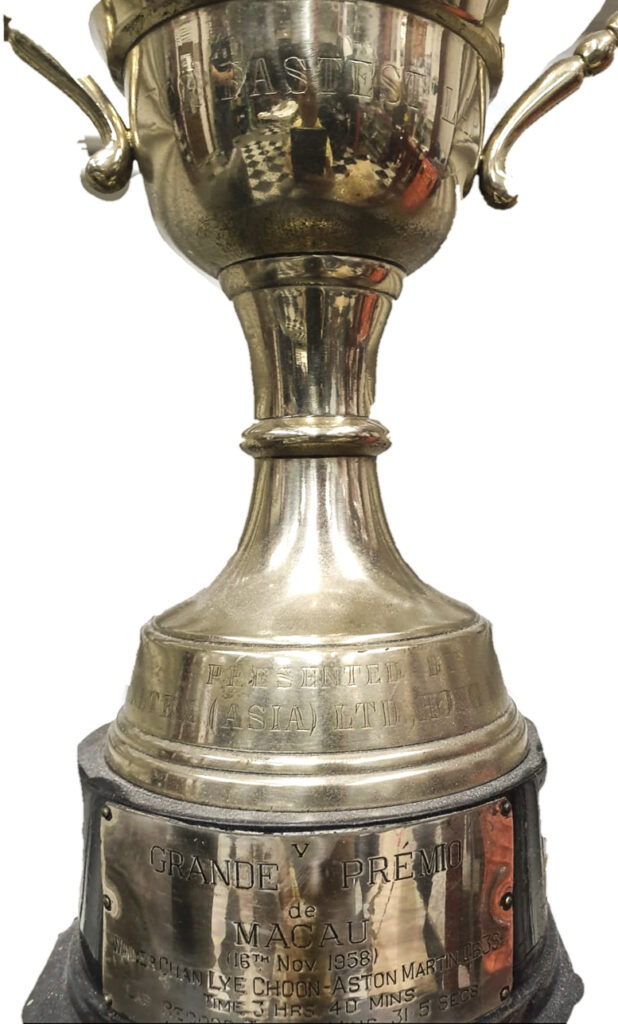
The 1958 Macau Grand Prix Fastest Time of Day trophy in the Rewind Media collection.
WIN ON SUNDAY
As the saying goes, win on Sunday, sell on Monday. Eastern Auto used motor sports and the success of their cars in the region as a platform to help the company sell their expensive sports saloons, the DB2 and DB2-4, Lagonda, and their range of stylish, if somewhat unconventional, Citroëns and Lancias and Jawa motorcycles, all in a country with a population of just 1.2 million and a motoring club with a membership of just 396. This was against a very fluid backdrop of government policies favouring Commonwealth imports and the push towards a local car assembly industry.
After his outstanding win at the Macau Grand Prix18, Chan received an invitation to race the car at the 150 mile (240km) New Zealand Grand Prix at Ardmore on 10 January 1959 against the world’s top drivers such as Jack Brabham, Stirling Moss, Bruce McLaren, Carroll Shelby and Ron Flockhart. Chan declined the invitation due to work commitments. After all, there was barely enough time to prepare the Aston Martin for another long journey south to New Zealand. It wouldn’t be the first time he declined such an invitation, he turned down a 1960 invitation as well, perhaps reflecting the tougher conditions the 42-year-old was facing with his Eastern Auto Co.
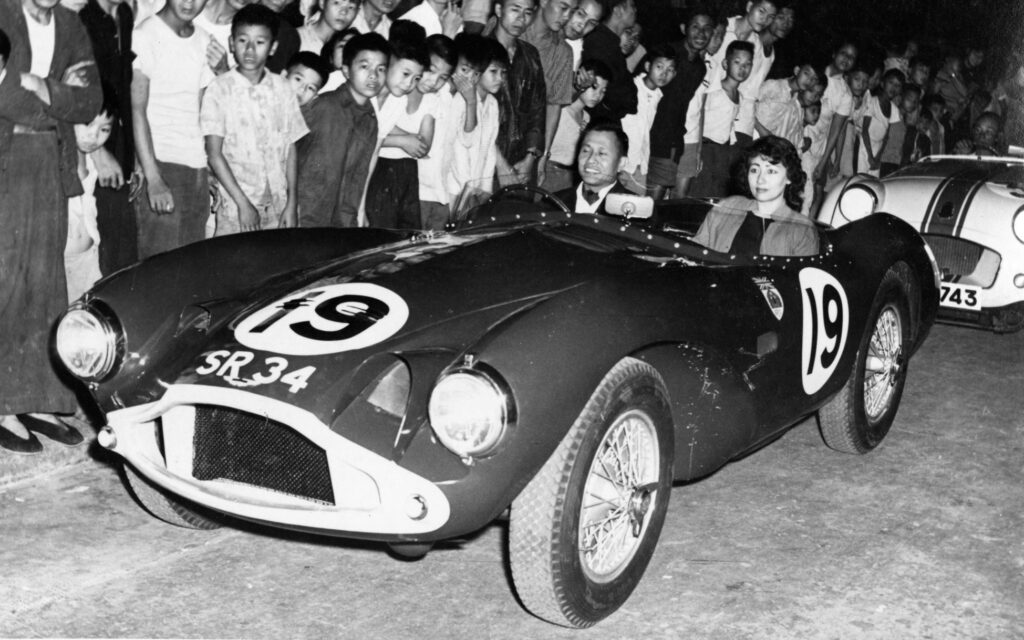
Chan Lye Choon followed up his 1958 Macau Grand Prix victory with a fine third place finish the following year.
A couple of weeks later, Chan entered the DB3S at the Dover Kilo19. The car was still very competitive. On 15 March 1959, Chan set FTD and bagged three new class records at the Lim Chu Kang Sprint, a great effort at a sprint that the Coopers of Moncrieff/Milne and indeed, Chan himself, usually dominated. There was one more attempt at the Macau Grand Prix that year against some very stiff opposition in the form of Ron Hardwick’s Jaguar XKSS20 and Peter Heath’s Lotus Eleven FWA Climax21. The front row of the grid consisted of the XKSS and the Lotus Eleven, and Bill Wyllie’s two-stroke Auto Union 1000 RS. The roads had been resurfaced and track times were expected to plummet, which they did, and Hardwick extracted a measure of revenge by lapping the Aston Martin by the eleventh lap. Chan motored on and finished a creditable third, two laps behind the XKSS and the Auto Union 1100 RS. Behind the DB3S was Singapore-based Jan Bussell in his cigarette-box Fribus Special22. The XKSS23 had shattered lap and course record.
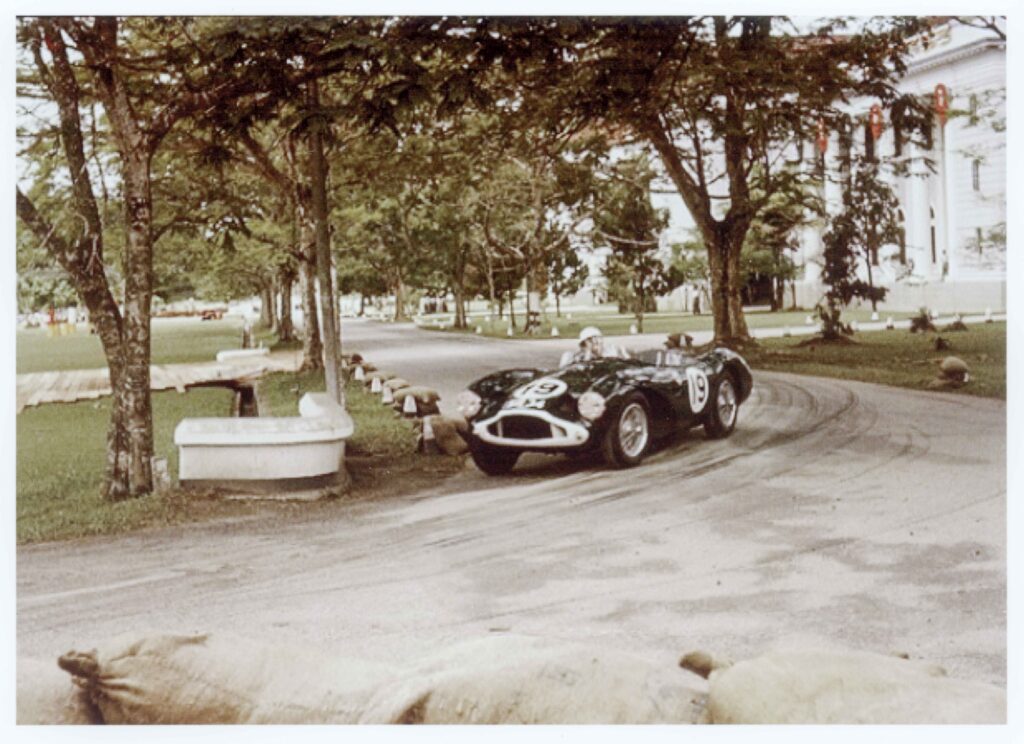
A win in the Johore Coronation Grand Prix Sports Cars support race was all Chan Lye Choon could muster as Bill Wyllie romped home with the Grand Prix trophy in his Auto Union RS 1000. Chan had already sold the car to Malayan planter Ian Barnwell.
When the Johore Grand Prix was revived in 196024, Chan’s DB3S was deemed competitive enough to be entered for both the 5-lap sports car race (which it won convincingly) and the main Grand Prix (won by Bill Wyllie in the Walter Sulke25-entered Auto Union 1000 RS). The 1000 RS had the measure of the competition once the skies opened up and the DB3S only managed to finish third, behind Wyllie and Tony Huggett in a Lotus Eleven Le Mans Climax. Fastest time was set by Peter Heath in another Lotus Eleven – a good three seconds faster than Chan’s time. It was no surprise that Chan soon switched allegiance to one of the newer sports cars makers, in this case, Eric Broadley’s Lola. In came a Lola Mk 1 and out went the DB3S.
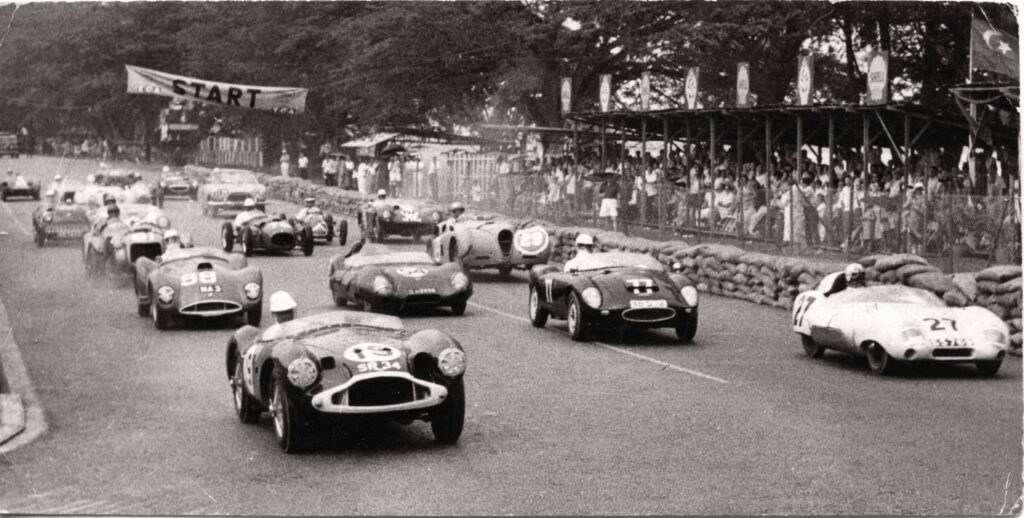
Start of the 1960 Johore Coronation Grand Prix showing the dominance of sports cars in the region. For the history of the 1960 Johore Grand Prix, see JOHORE GRAND PRIX – PART 2: 1960-1963
Rare color footage of Chan Lye Choon in action in DB3S/106 – winning the Sports Cars Support Race to the 1960 Johore Coronation Grand Prix.
ANOTHER PALM
DB3S/106 wasn’t put to pasture just yet. Eccentric Malayan planter Ian Barnwell bought the car and entered it at various sprints and hill climbs in Malaya. Up until the DB3S arrived, Barnwell, who was already in Malaya as an assistant planter in the Selaba Estate in Teluk Anson in Perak as early as 1955 (possibly already in Singapore by 1953) and later on in Temerloh in Pahang, was racing a battled scarred cream-coloured Jaguar XK120 (road registration SR6267) that he would run sans bumpers and windscreen, which he would drive from his plantation in Pahang to wherever a sprint or hill climb was taking place. His first recorded motor sport event was at the 4 October 1959 Gap Hill Climb in Singapore, followed by the Forces Motoring Club’s New Year Sprint at the Dover Kilo in Singapore on 10 January 1960.
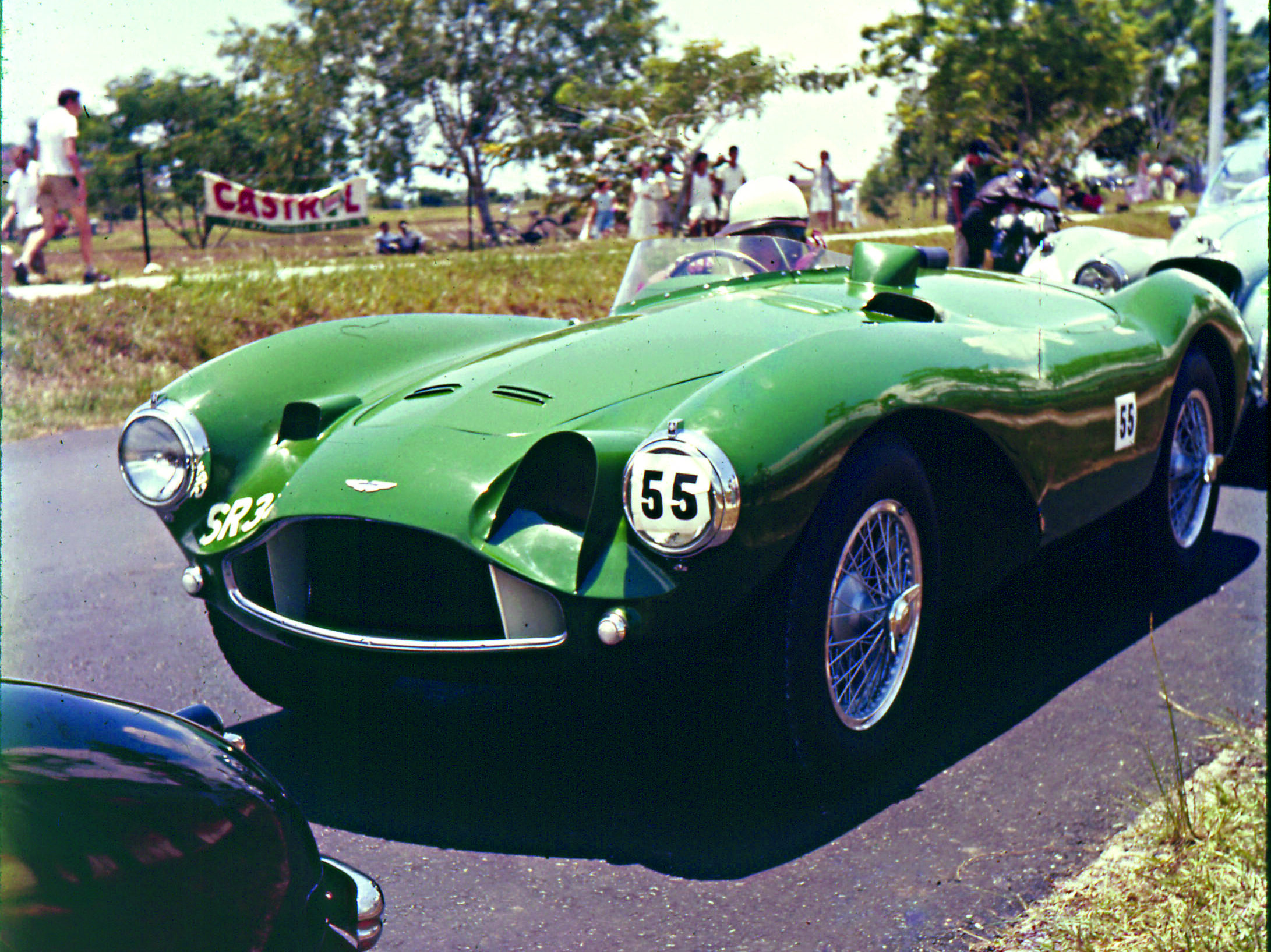
The DB3S at the Dover Kilo in Singapore. Number 4 Supply Depot was based at Dover Road, the site of the Dover Road Kilo Sprint in the late 1950s. The event was organised by the Forces Motoring Club, Singapore Branch.
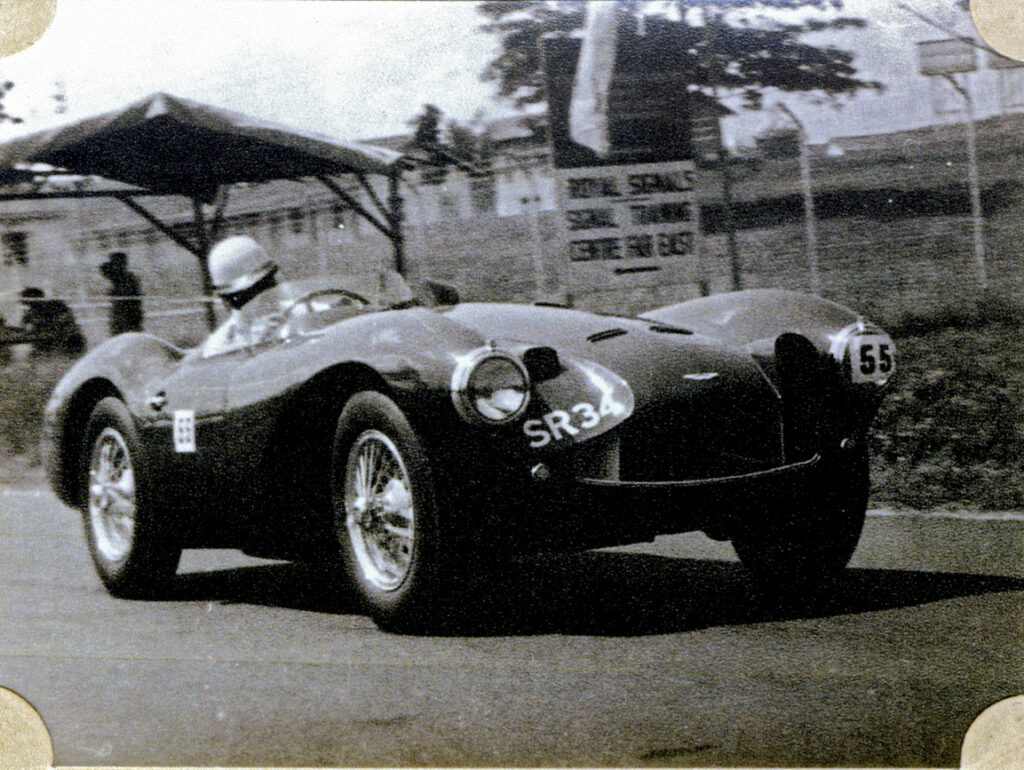
DB3S of Chan Lye Choon at the Dover Kilo Sprint September 1958.
His first competitive event in the Aston Martin was at the Gunung Ledang26 Hill Climb (Mount Ophir) in Johore on 12 June 1960 where his friend and fellow planter Peter Cowling (in the ex-Ferguson 498cc Cooper MkIV) set FTD with Barnwell in the DB3S second fastest. The car was entered at the Tunku Abdul Rahman (TAR) Hill Climb and Sprint at the Diplomatic Enclave of Kenny Hill on 23 October 1960. Here, Barnwell set a new course record. In June 196127, Barnwell, now on the committee of the Malayan Motor Sports Club28, entered the car in the Johore Grand Prix against much newer opposition such as Chan’s new green Lola Mk 1 FWE Climax, Peter Brown’s ex-Works Lotus 17 and his good friend Peter Cowling’s Formula 2 T51 1.5-litre Cooper FPF Climax29 (which set FTD).
Barnwell was now based in Muar, Johore and the car was now painted sky blue, with a longitudinal black strip flanked by two yellow stripes, the colours of the Johore royal family. Barnwell recalled that, “Only the royal family of Johore were allowed to use the colours, so Tengku Mahmud had to ask his father for special permission to allow me to use them.” Once approval was obtained, Barnwell, “could roar through villages and towns in Johore, and the police snapped to attention and saluted! I also had priority on the ferries!”
Barnwell recounted his experience at the 1961 Johore races. “Tengku Makhota of Johore, Tengku Mahmud, was a motor racing enthusiast. As Sultan of Johore, he later became Yang di Pertuan Agong. He was such an enthusiast that he let Peter Cowling and I leave our cars in the front porch of his Istana before the 1961 Johore Grand Prix instead of in the ‘parq fermée’. When we went to collect the cars before dawn on the morning of the race, we found a soldier with rifle and bayonet guarding them!”30
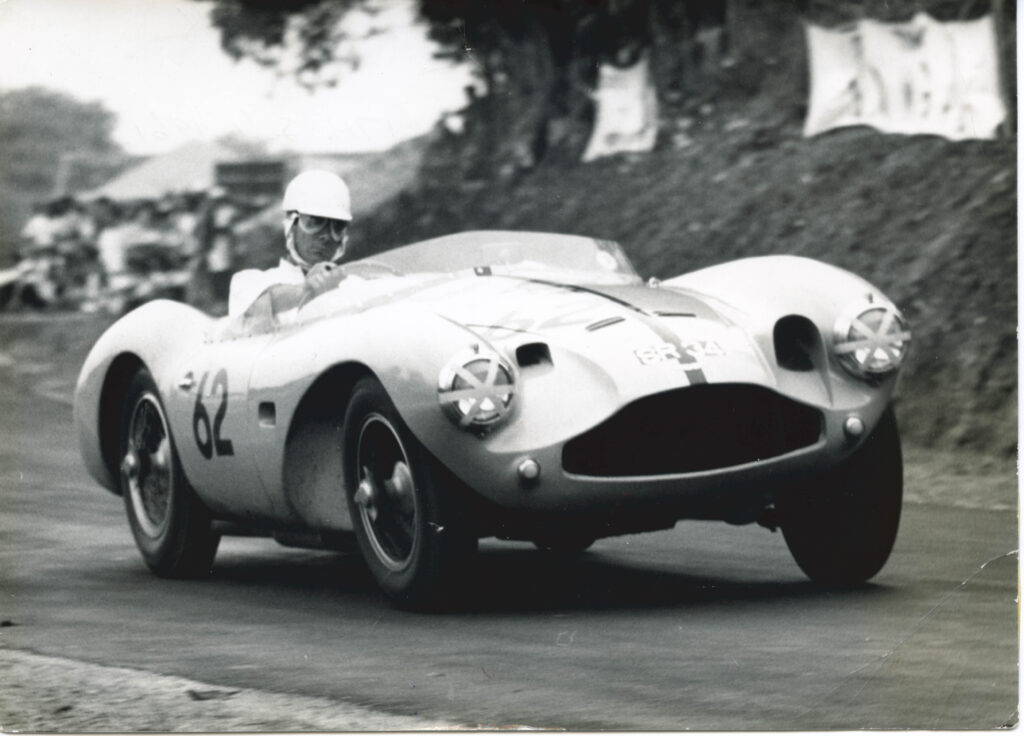
Barnwell maintained the Singapore road registrations (SR34) but changed the car colour from green to blue.
STREET FIGHTER
Barnwell was at it with the Aston Martin at the treacherous Sembawang Nursery Circuit’s Summer Sprint on 23 July 1961, the only circuit in Singapore and indeed, Malaysia, for which to take the car for a spin as a prelude to the inaugural Singapore Grand Prix in September, outside of racing around the streets or around his oil palm estate.
Long in the tooth, the old dog still had what it took to win one more Grand Prix. It was a magnificent win on a tough and relatively unknown circuit with plantation and dwellings on one side and jungle on the other was strewn with chicanes made up of sand bags, drains, ravines and lampposts. And it came from a planter in Temerloh, Pahang, so said the press reports, though Barnwell recalls that he was based in Muar at the time. Still, that wasn’t the end of the car’s racing history, although he attempted to sell the car at the end of September that year31, the car stationed at the oil palm plantation at Nordanal Estate on the right bank of the Muar River. Car and driver were up in Kuala Lumpur’s Diplomatic Enclave for the TAR Sprint and Hill Climb on 8 October 1961, entered under Ecurie Utan (jungle in Malay).
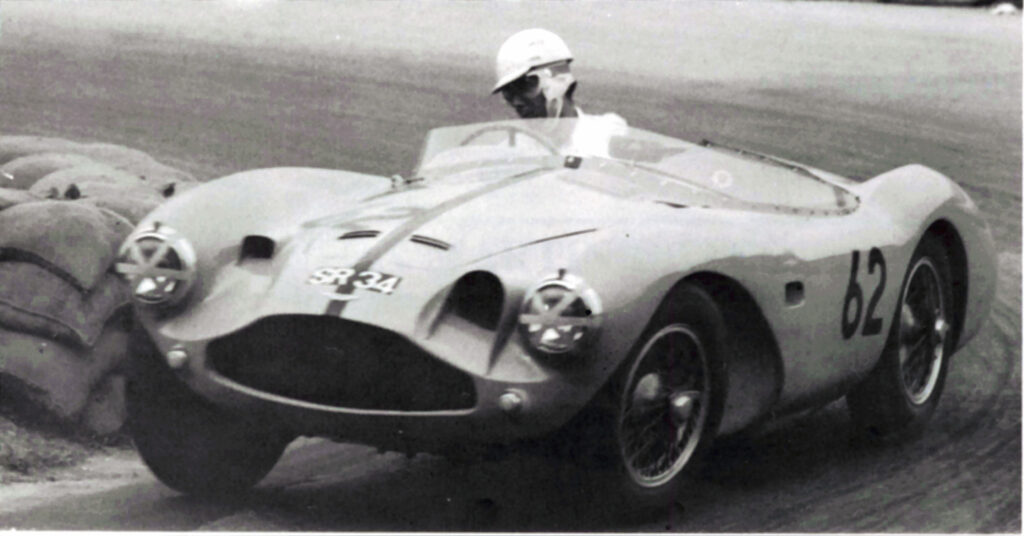
On the way to victory in the inaugural Singapore Grand Prix in September 1961.
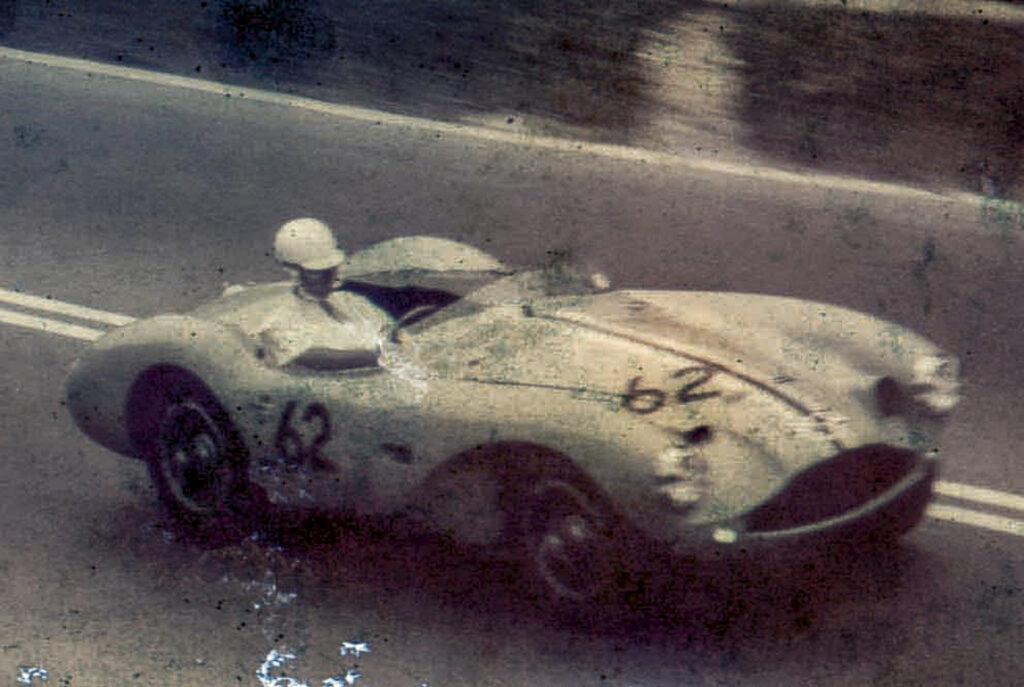
Ian Barnwell on his way to a momentous victory at the inaugural Singapore Grand Prix (1961).
In March the following year, racing under Barnwell’s Ecurie Utan banner at the Malayan Motor Sports Club’s National Sprint at Kenny Hill’s Diplomatic Enclave, Chan had one more go in his old car and won his class while Barnwell raced fellow planter and friend Peter Cowling’s T51 Formula 2 Cooper Climax. The DB3’s post-1962 history is sketchy but it seems Barnwell sent the engine back to the factory to address a damaged water pump and corrosion in the block from “use of rain water for cooling”.
LAST FLING
The ten-year-old car was ready for the 1964 Grand Prix in Singapore at the end of March. Barnwell, a bit rusty from lack of racing, never made it to the starting line for the Grand Prix. In a freak accident, he spun on the very fast right hander after the Start-Finish line on New Upper Thomson Road during Saturday’s practice, killing a course marshal in the process. It was a stretch where cars would be travelling “well in excess of 100mph”32. The racer remembers coming up behind a rather slow Lotus, “and was in a hurry to get past him.” He took the left side of the track for the upcoming bend, off the usual racing line, which he must have realised was on an adverse camber. Crash!
The car’s body was a mess after its altercation with a tree but the engine, it seemed, did not sustain any damage. Barnwell was unhurt. The locals would never have touched the car after that incident and some say it languished at Tan Ah Bee’s Grange Road workshop in the compounds of Lim Peng Han’s Paterson Hill home. Its remains were purchased by a knowledgeable enthusiast and bundled it off from whence it came, thankfully saving it from being converted into housing construction rebars. Barnwell certainly didn’t’ dump the car and retained ownership till it was sold. He continued his career as a planter, moving to Sungei Samak Estate and getting married in October 1966 to Eileen Brown33. The present history of DB3S/106 is not within the scope of this article.
Footnotes
- The Certain Sound – Thirty Years Of Motor Racing by Joyhn Wyer. Edita, 1981.
- Passengers on board the P&O liner Chusan included Richard M. Arblaster, Chan Lye Choon and wife, John F.L. Gwatkin-Williams, Bruce MacRae-Smith and Henry A Stonor. All these would be, or already were involved in regional motor sports. The vessel departed London on 31 October 1952 and arrived in Singapore on Saturday 22 November 1952.
- Chan Lye Choon [b. 3 September 1918 d. 18 August 1984, age 66]. Chan was one of the four sons of Compradore Chan Swee Hong, founder of Eastern Auto Co.3 A brief history of the Eastern Auto Company: The Eastern Auto Company was officially established in Singapore on 1st October 1921 with address at 156 Orchard Road, what was Motor Row in the city. An earlier advertisement, dated 13th September 1921 (Straits Times), saw International Motors advertise a Citroën 10HP car for sale at $2,750. International Motors was still advertising Citroën cars on September 5th October 1921, the very day newly formed Eastern Auto Company officially announced commencement of business as sole agents for Citroën in the Straits Settlements and the Federated Malay States. Directors of the new company were Tan Teck Yew and Chan Swee Hong (Straits Times, 4th October 1921 – NOTICE). In conjunction with the establishment of Eastern Auto Company was the cessation of a partnership between the following: Chan Kim Swee, Chia Yee Soh and Tan Teck Yew. Their company operated as Motor Engineers and Importers of 23, 24, 25 and 26 Orchard Road under United Motor Works (or Chop Hup Soon [Hup Soon means “United” in Chinese]. The partnership had been dissolved as from 30th September 1921 with Tan Teck Yew and Chan Kim Swee retiring from the business by mutual consent. Post war, the business operated from 61/63 Orchard Road, with the company’s workshop at 6 Oldham Lane. Agencies held included Citroën, Nash & Ariel motorcycles. On 13th September 1949, Compradore Chan Swee Hong, founder of Eastern Auto Co., passed away at his home in Telok Kurau Road (Lorong N). Aside from being a director of Eastern Auto, Chan was Compradore of the Banque de L’Indo-chine. The EAC business devolved upon his four sons, Chan Lye Soon, Chan Lye Huat, Chan Lye Choon and Chan Lye Koon. By the end of 1956 EAC carried Aston Martin, Lagonda, Citroën, DKW and Lancia, amongst other brands such as Abarth exhausts. In September 1957, Chan Lye Huat and Chan Lye Soon petitioned to wind up the business (10 September 1957). The remaining stakeholders were Chan Lye Choon and Chan Lye Koon. The business moved to 185 Clemenceau Road from 14 September 1961 and was retained until April 1971 following closure of EAC and change of ownership of the French car agency to Henry Ang Agencies. Chan Lye Choon and Henry Ang Thian Huat had stood guarantors for Eastern Auto Company for $61,476 to get the bank to release five Citroën cars for which EAC had not paid on receipt o the drafts and shipping documents. The trust receipt was signed for $21,682 on 12 Dec 1965 and another on by Chan Lye Choon on 4th Apr 1966 for $39,794. EAC had since wound up ops and the bank was seeking to recover the money from the Guarantors.
A comprehensive account of the company’s history can be found in Pierre Jammes’ book Citroën DS stories in Asia/Histoires de Citroën DS en Asia [http://www.citroenet.org.uk/resources/books/ds-in-asia.html]. Full accounts of the brands under EAC have also been comprehensively documented by the family of the former owners of Eastern Auto on social media platform Facebook and by Singapore Grand Prix, Eastern Auto Company (and all its associate businesses), Aston Martin/Citroën/Abarth/Merlyn/Jawa/Mini expert Shane Lim.
- In 1923 Citroën Cars Limited was set up in London with its headquarters in the Citroën Building, Brook Green, Hammersmith to take over the import and distribution of Citroën vehicles throughout the country. The rising demand for the vehicles and the imposition of the McKenna Duties on imported vehicles led André Citroën to set up an assembly plant to manufacture cars for the British domestic and Empire (later Commonwealth) markets, principally for right hand drive cars. The Citroën factory, in the Slough Trading Estate was opened on 18th February 1926 and was to continue building cars until 1965 when the operation became dedicated to sales and marketing. The Slough cars were equipped with extras not fitted to the domestic market vehicles.[/efn_not], in Berkshire, where he called upon the principals at Citroën, for which Eastern Auto Co. had the local agency since October 1921. Chan had a couple of additional missions. One was to cast his net and bag another automobile and motorcycle agencies for the growing Malayan5I have adopted the use of Malayan to include both East and West Malaysia and Singapore if the period in question is before August 1965, unless specific to Singapore. Singapore attained independence in August 1965.
- See FROM A FEDERAL STORE
- The car carried Singapore registration SR34.
- Chassis LML/650 was a 2.6-litre Coupe with Singapore registration SB7745C.
- Both brothers missed the Lim Chu Kang Half-Mile Sprint on 19 February 1956, the Simpang Pulai Hill Climb near Ipoh on 26 February, the Princess Elizabeth Sprint in Singapore on 4 March, the Gap Hill Climb on 29 April, the Lornie Kilo on 13 May, the Bukit Batok Hill Climb on 10 June and the Gunung Rapat Hill Climb on 19 August. The DB3S and Chan Lye Choon returned to racing at the Gap Hill Climb on 14 October, the Aston Martin making it Gap debut and now painted in a light cream colour.
- Steve Lancefield was a Norton wizard and employed his expertise not just to the Manx motorcycles but to the 500cc Manx Norton “double knocker” racing Coopers and Kiefts, often for Ecurie Richmond’s Eric Brandon and for John Cooper.
- The Changi Circuit Race, organized by the Singapore Branch of the Forces Motoring Club, was held at R.A.F. Changi on 9 June 1957 and consisted of just six events, for both cars and motorcycles. The Chan Aston Martin DB3S won the 10-lap race for Formula Libre cars.
- Freddie Pope’s #22 Jaguar has Brian Hawes’ XK120 Monoposto body on Pope’s XL140 OTS (chassis 800011). It was simply listed as a Jaguar Special, occasionally as an XK120 Special. Pope had long since sold his XK120 Roadster so the 1958 Macau entry was his XK140 with occasional racing body from the Hawes XK120 that Pope owned.
- Bernard Arnold’s Warrior Bristol is detailed in JUNGLE WARRIOR – The Warrior Bristol in South East Asia
- Phil Caroline’s 3917cc Allard J2X, first seen in Malaya in 1952 at the Johore Grand Prix. Later with a 4,736cc McCulloch supercharger (275hp) Studebaker Golden Hawk engine (run in 1958). Still in Singapore as late as 1971.
- Bill Wyllie’s Buckler Mistral Special was a Buckler DD2 with a Microplas Mistral body? Loris Goring, then editor of the Singapore Motor Club’s Gazette, recalls that the car had a Buckler DD2 tube frame chassis with De Dion rear suspension and that “it held the road remarkable well compared to say a TR2 or TR3. See BAMBOO & BUCKLER
- Very little is known of Francis Jan Bussell’s little four-wheeler Berkeley save that he had been convinced to race it by fellow pilot Phil Caroline, who owned the V8-engined Allard J2.
- The Grand Prix victory resulted in Chan attaining British Racing Drivers’ Club membership (BRDC).
- The Dover Kilo was held on 25 January 1959. FTD was set by Neil Moncrieff in a Mk V Cooper JAP. Chan entered his Aston Martin DB3s, his twin cam MGA and his Cooper JAP.
- The white Jaguar XKSS, chassis XKSS 757, belonged to Hong Kong’s K.F. Chang. It was first raced in Hong Kong on 29 October 1957 by Martin Redfern at the Sek Kong Sprint.
- Peter Heath’s Lotus Eleven, chassis 522, was eventually sold to Malaysian racing ace Saw Kim Thiat early in 1961.
- The Fribus Special was based on a post-war Riley and named after its owner, Francis Jan Bussell. See MONSTERS & MAVERICKS MALAYAN/SINGAPORE POST-WAR SPECIALS
- The Jaguar XKSS went on to win the 1960 Macau Grand Prix as well, this time in the hands of Martin Redfern.
- The 1960 Johore Grand Prix was held on 20-21 February 1960 and called the Coronation Grand Prix, in honour of the patron of the Singapore Motor Club, His Highness Colonel Sir Ismail, D.K., S.P.M.J., S.M.N., K.B.E., C.M.G., Sultan of Johore.
- Walter Martin Sulke (1923-1994) was the Hong Kong importer of Mercedes-Benz and DKW cars. See JOHORE GRAND PRIX – PART 2: 1960-1963
- The Gunung Ledang (prev. spelling Gunong Ledang) – otherwise known as the Mount Ophir Hill Climb, in the Tangkak District of Johor. The Malayan Motor Sports Club had toyed with the idea of a hill climb up Mount Ophir in the late 1950s, with plans for the longest hill climb ever held in the region.
- The Second Johore Coronation Grand Prix was held on 24-25 June 1961. For details on the 1961 Grand Prix, see JOHORE GRAND PRIX – PART 2: 1960-1963
- The MMSC’s 1960/61 committee consisted of President Dr. W.H. ‘Bill’ Dyson; Leslie A. Worley as Vice-President; Mark G. Spragge as Club Captain; Mrs Worley as Secretary, Desmond Gustavus as Treasurer; Ismail bin Abdul Majeed as Social Member; Lam Im Kong in charge of motorcycling; S. Theraviam, Michael Chee, Ian M. Barnwell and W. Carter on the general committee.
- See Cooperholic Coup.
- Interview with Ian Barnwell, 2008.
- Straits Time, 30 September 1961 – For sale advertisement offering the road-registered DB3S with triple twin-Webers, Alfin brake drums and eight Borrani alloy wheels. The asking price was M$15,000 (parity with the Singapore Dollar and 8.586 to the GBP, or £1,750). The car was parked at Barnwell’s oil palm plantation, at Nordanal Estate in Muar, Johore.
- Straits Times, 18 April 1964, pg.15. Driver defends Grand Prix decision
- Eileen Brown was daughter of A.G. Brown of 15 Corbiehill Avenue, Edinburgh.

